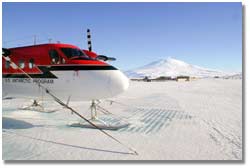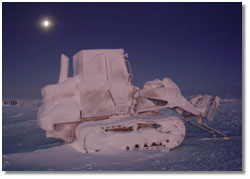 |
|
|
 |
||
|
||||||||||
|
Images/B-Roll: For b-roll of Twin Otters flying at Rothera in Betacam SP format, contact Dena Headlee, (703) 292-7739 / dheadlee@nsf.gov
NSF Considers Alternatives for Treating Ill South Pole Worker
|
|
Larger versions (Total Size: 2,738KB) of all images from this document |
|
ARLINGTON, Va.—National Science Foundation (NSF) officials are considering several alternatives to care for and treat a worker at Amundsen-Scott South Pole Station. NSF manages the U.S. Antarctic Program (USAP), which coordinates all U.S. scientific research and logistics support on the southernmost continent.
Officials of NSF's Office of Polar Programs have been consulting with the South Pole station's physician and medical specialists in the United States via a telemedicine link to provide the necessary care. But concern that the individual's condition could possibly worsen has prompted NSF to develop contingency plans to evacuate the patient to the United States, where more advanced medical facilities are available.
The patient, an employee of Raytheon Polar Services Co. (RPSC), of Centennial, Colo., NSF's Antarctic logistics contractor, has requested anonymity. NSF is honoring that request. The specifics of the patient's condition are being kept confidential. The illness is not contagious and no one else at the station is at risk.
"The patient remains in stable condition and is able to move about," said Will Silva, South Pole Station physician. "We continue to monitor his condition to decide whether an evacuation is in the patient's best interest."
In preparation for a medical flight, two Twin Otter aircraft, operated by Kenn Borek Air Ltd. of Alberta, Canada, under contract to RPSC in support of the USAP, departed from Canada earlier this week for Punta Arenas, Chile. There, they will await a decision to continue on to the Pole and return the patient to the United States for care.
If a flight becomes necessary, the British Antarctic Survey (BAS) will allow the planes to land at Rothera, its station on the Antarctic Peninsula, to await favorable weather for one of them to fly to the Pole. BAS also allowed its facilities at Rothera to be used in April of 2001, when South Pole Physician Ronald Shemenski was evacuated for treatment of pancreatitis.
At that time, the evacuation flight through the cold and darkness of the six-month polar night was one of the most challenging on record.
A roundtrip flight from Rothera to the Pole would take a minimum of 30 hours, including a mandatory rest period for the crew, and would face the potentially challenging weather conditions of the polar spring.
Spring warming produces strong winds and extremely changeable weather that is difficult to predict. Unlike in April of 2001, however, the amount of daylight is increasing. Nevertheless, such a flight would pose some measure of risk to the aircrews, which will be taken into account in making the final decision on an evacuation attempt.
As the Twin Otters are en route to Punta Arenas, NSF officials are also considering whether a U.S. military aircraft, staging from New Zealand, could be used to assist in an evacuation, flying to McMurdo Station, NSF's logistics hub on the coast of Antarctica, where it would meet the Twin Otter arriving from the Pole, some 1200 kilometers (800 miles) away.
Simultaneously, NSF has requested through the New Zealand Antarctic Program to have C-130 Hercules aircraft from the Royal New Zealand Air Force (RZNAF) 40 Squadron stand by to make a flight to McMurdo to meet the Twin Otter.
The various contingencies are being considered in order to accommodate the possible deployment of a long-range aircraft as well as to take advantage of features of different aircraft to use the several airfields at McMurdo Station.
As spring comes to the Southern Hemisphere, normal flight operations will soon commence to support the several thousand researchers and other personnel who travel to Antarctica under the auspices of the U.S. Antarctic Program.
The Twin Otters flown by Kenn Borek as well as U.S. Air Force C-141s and C-17s, ski-equipped LC-130 Hercules transport planes flown by the New York Air National Guard and RZNAF C-130s all contribute to the program's airlift capacity.
Usually, the first flights into coastal McMurdo take place at the end of September.
Flights to the South Pole, however, do not begin until late October or early November, when temperatures have increased. The average temperature at the Pole at this time of year is –60 degrees Celsius (–76 degrees Fahrenheit).
Currently some 58 scientists and staff are spending the austral winter at the South Pole station. Some are overseeing the operation of highly sophisticated telescopes that take advantage of the pristine Polar atmosphere as an astronomy observatory, some are working on building a new, modern station at the Pole and others work in a variety of support roles that keep the station functioning.
NSF officials will continue to monitor the patient's condition to determine whether an evacuation is necessary.
For a fact sheet on astronomy at the South Pole, see: http://www.nsf.gov/od/lpa/news/media/2000/fsastro.htm
Several recent observations taken at the South Pole have help describe the nature of the universe in its infancy. For more information, see:
- Scientists Use South Pole Telescope to Produce the Most Detailed Images of the Early Universe
http://www.nsf.gov/od/lpa/news/02/pr0299.htm
- Cosmologists Reveal First Detailed Images of Early Universe
http://www.nsf.gov/od/lpa/news/press/00/pr0025.htm
For more information about Kenn Borek Air Ltd., see: http://www.borekair.com/
For background on the evacuation of Dr. Shemenski, see: http://www.nsf.gov/od/lpa/news/press/01/medevac2001.htm
The National Science Foundation (NSF) is an independent federal agency that supports fundamental research and education across all fields of science and engineering, with an annual budget of nearly $5.3 billion. NSF funds reach all 50 states through grants to nearly 2,000 universities and institutions. Each year, NSF receives about 30,000 competitive requests for funding, and makes about 10,000 new funding awards. The NSF also awards over $200 million in professional and service contracts yearly.
Receive official NSF news electronically through the e-mail delivery system, NSFnews. To subscribe, send an e-mail message to join-nsfnews@lists.nsf.gov. In the body of the message, type "subscribe nsfnews" and then type your name. (Ex.: "subscribe nsfnews John Smith")
Useful NSF Web Sites:
NSF Home Page: http://www.nsf.gov
News Highlights: http://www.nsf.gov/od/lpa
Newsroom: http://www.nsf.gov/od/lpa/news/media/start.htm
Science Statistics: http://www.nsf.gov/sbe/srs/stats.htm
Awards Searches: http://www.fastlane.nsf.gov/a6/A6Start.htm
|
|



